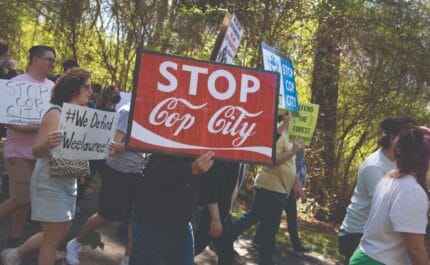Eight years stuck on the Suez Canal
Shortly after being freed from the banks of the Suez Canal on 29th March, the Ever Given was impounded with its crew still aboard. But it’s not the first time a cargo ship has been prevented from leaving the waterway: in 1967 the outbreak of conflict led to several boats being stranded in Egypt for eight years. In DG #42 we told the story of how an autonomous floating community formed in the middle of a warzone

Scuttled ships block the entrance to the Suez Canal at Port Said following the Six-Day War between Israel and Egypt, circa 1967. Photo: Universal History Archive/Universal Images Group via Getty Images
29th March 2021 (Taken from: #42)
The crew on the Melampus faced a dilemma. War between Israel and Egypt appeared imminent, and passing through the Suez Canal could place them right in the danger zone. But the alternative was an 8,200km detour around southern Africa. A nine-day journey home, after many months at sea, would be extended by weeks. The captain of the British cargo ship put it to a vote, and the crew chose to take a chance on the artificial waterway.
Unfortunately the Melampus ended up in the wrong place at precisely the wrong time. On 5th June 1967, just as the British vessel joined a convoy of cargo ships passing through the canal, Israel launched a preemptive attack on nearby Egyptian airfields. Graham McMorine, an engineer on the Melampus, got a close-up view of the outbreak of war. Israeli jets flew past barely ten metres above the water, almost skimming his head, using the cargo ships as cover before obliterating the Egyptian air bases at El Kabret, a kilometre and a half west of the canal.
Later that day Egyptian president Gamal Abdel Nasser ordered the Melampus and the other cargo ships that happened to be passing through the Suez Canal at the time of the Israeli attack to halt their journeys. Fourteen vessels gathered in the Great Bitter Lake, a large body of salt water that served as a passing point. To stop his enemies gaining access to the canal, Nasser had it closed off at both ends, trapping the ships between two warring armies, with the Israeli forces on the east bank and the Egyptians to the west.
“Imagine the feeling of shock when we were informed that the canal had been blocked,” McMorine says. He initially feared being taken hostage. He’d left England straight after his wedding, and his new wife Margaret was at home, counting down the days until his return. He remembers his primary concern at the time: “Would we ever see our loved ones again?”

The Polish crew of the Djakarta visit the crew of the British ships the Melampus and the Agapenor. Photo: Brian McManus
The war lasted only six days, by which time Israel had seized the West Bank and East Jerusalem from Jordan, the Golan Heights from Syria, and the Gaza Strip and Sinai Peninsula from Egypt. Thankfully, and perhaps somewhat miraculously, no one on the stranded ships was injured in the fighting.
The conflict was over, yet Nasser didn’t allow the ships to budge. Did he intend to use them as a bargaining chip in peace negotiations? It wasn’t clear, but the ships – and, for the time being, the hundreds of people aboard – weren’t going anywhere. The vessels would end up being stuck on the lake for eight years.
In the days after the fighting stopped, the crews of the ships felt abandoned, with no word from the Egyptian authorities and no way of contacting family back home. The days were long, dull and very hot. Running short of water, they began distilling seawater, but it tasted disgusting. With limited work to do, the seafarers played chess, listened to music on their cassette players, sunbathed and went swimming. “After a while you got fed up,” says McMorine, who passed the days by making a model boat. “Boredom really did start setting in.”
Fortunately, a huge amount of fresh and frozen food was stored in giant fridges and freezers, intended for buyers at the ships’ destinations. The crews began to exchange fish, meat and seafood, as well as fruit, eggs, rice and alcohol. On the Port Invercargill there were vast quantities of fortified wine, while over 200 cartons of lager were found on the Scottish Star, and a Bulgarian crew discovered they could make brandy. The seafarers used their lifeboats to travel from ship to ship to exchange food, drink and other goods. Friendships began to form.
The seeds of something special had been planted. Stranded in a conflict zone, in the middle of the Cold War, crews from both East and West started to come together in the name of friendship and solidarity to form an autonomous community.
Graham McMorine did see his loved ones again. Two months after the ships’ voyages came to an abrupt and unwanted halt, the shipping companies and the Egyptian authorities reached a deal and the stranded seafarers were allowed to leave. McMorine was reunited with Margaret on the day of their first wedding anniversary.
The seafarers left their vessels behind them. Each of the ships on the Great Bitter Lake – four from the UK, two from West Germany, Sweden and Poland, and one each from France, Czechoslovakia, Bulgaria and the US – was akin to a vast warehouse, transiting the Suez Canal to transport food, drink, clothing, toys and industrial materials across the globe. The onboard cargo, and the boats themselves, were assets the shipping companies hoped to protect, and over the following eight years they sent out a series of relief crews to look after the stranded vessels.
The crews, typically paid extra for working in a warzone, would stay for up to nine months at a time; in total, over 3,000 men (and, on one of the Swedish ships, one woman) lived on the 14 vessels, some returning more than once. And from 7th October 1967 onwards, when all 14 crews met on the Melampus to formalise the ties they had created exchanging goods, every person who served on the Great Bitter Lake had the opportunity to join a unique floating community where national differences were put aside.
In the middle of the Cold War, crews from both East and West started to come together to form an autonomous community”
At that very first meeting of the Great Bitter Lake Association (GBLA) it was agreed that everyone was to be treated equally, whether they were from the East or the West. There may have been a bitter Cold War raging in the outside world, but there would be no Cold War on the Great Bitter Lake. The boundaries between the ranks on the ships were softened; captains remained in charge, but they were happy to join in social activities and were now to be addressed by their first names – preceded by Captain, to show a modicum of respect. The subscription fee for joining the organisation was a pound, which included a membership card and a GBLA tie, to be sent out from the UK.
Every weekend the GBLA held a ‘church’ service, attended by all the crews. But this wasn’t the sort of traditional religious event the crews might have attended on dry land. Brian McManus, who arrived in December 1968 to captain the Agapenor and Melampus ships, by now moored together to be cost-effectively managed by a single crew, recalled his first experience of worship, GBLA-style. Upon arrival the captain of the German host ship, the Nordwind, welcomed him to Sunday service with the words, “Have a beer, Brian”, before handing him a Tuborg. Services would finish with a rousing rendition of the GBLA ‘national anthem’, sung to the tune of the Beatles’ ‘Yellow Submarine’:
“Sky of blue, sea of green
Thanks for vodka, beer and gin
Associated many men
In the Great Bitter Lake den”
Church was much more than a drunken singalong though. It was the place for discussing the exchange of tools, materials and skills – all offered free on the basis of need. It was also where the social and sports activities on the Great Bitter Lake were organised. And there were many of them.
Every month the GBLA held a regatta. The crews modified the lifeboats and canal rowing boats, adding sails and extended keels, and spectators gathered on decks to watch the races. A weekly four-a-side football tournament was staged on the Port Invercargill, its deck transformed into a pitch with cargo nets for goals, and draped along the edges of the deck to prevent the ball flying overboard. There was a burger stand, and stalls for beer and betting. The teams – one for each ship – were split into two divisions, with relegation and promotion. McManus remembered the games as being “fast and rough”.

George Wharton competes in the high jump event at the Great Bitter Lake Olympics, October 1968. Photo courtesy of George Wharton
In 1968, the Polish crew of the Djakarta arranged a GBLA mini-Olympics, timed to coincide with the actual Games in Mexico City. They painted lines on the deck for the sprint races, used the crew’s mattresses for high-jump contestants to land on, and made bows, arrows and targets for the archery. “The atmosphere during the Games was fantastic,” says George Wharton, who first arrived on the Agapenor in 1967 and returned the following year. “Everyone played their part to make it the success it was.” He proudly recalls standing on the podium to the sound of the British national anthem. No athlete won more medals than Wharton although the Polish hosts, he recalls, won the Olympics overall.
The Poles were also enthusiastic practitioners of one of the more sedate activities organised by the GBLA. After the initial crisis of the Six-Day War, the seafarers were able to send and receive letters via the Suez Canal Authority. A continual stream of GBLA stamps was designed and produced to represent the community, although they had no postal value. This was painstaking work done on a minute scale. Some drew their designs by hand and coloured them with inks, crayons or even coffee grounds. Others used potatoes or lino cuts. Two of the ships had duplicators for printing. A particularly talented Polish seafarer produced a series of 14 different stamps, each featuring one of the ships, complete with tiny hulls, funnels, masts and cranes.
While most crew members had plenty of free time, the onboard chefs had their work cut out, conjuring up meals to make the best use of the ingredients stored onboard as well as local supplies purchased from the Suez Canal Authority. The German ship gained a reputation in the GBLA community for fine dining: lobster mayonnaise, smoked salmon and steaks were sometimes on the menu. If the French were hosting, you might eat the chef’s Great Bitter Lake speciality of aioli de requin – shark aioli (one of the ships had frozen shark in its cargo). The British boat lived up to national stereotypes by serving fish and chips at regattas. Whatever the occasion, there was always plenty of drink.
It wasn’t all fun, games and copious quantities of booze, though. Tensions between Israel and Egypt continued and escalated into confrontation in the War of Attrition, beginning in March 1969, which saw Israel retaliating against Egyptian attempts to push its forces out of the Sinai Peninsula. The crews were once again stuck in the middle of a conflict, and were terrified of being caught in the crossfire. McManus remembered how the “Egyptian artillery shattered the afternoon’s tranquillity with violent shelling.” The battles continued for more than a month, and McManus recalled one particularly alarming occasion when the Israeli warplanes opened fire directly over his ship. “The crew were literally shaking with terror,” he said.
Upon replacing Nasser as Egyptian president in 1970, Anwar Sadat announced plans to reopen the canal. But they involved an enormous and dangerous undertaking – a huge salvage operation was required to clear the canal of unexploded bombs and rockets, not to mention Israeli tanks, wrecked aircraft and even a passenger ship. Egyptian divers risked their lives to clear all the mines laid during the conflict. The 1973 Arab-Israeli War caused further delays.
As the years dragged on, the shipping companies reduced their costs, cutting crew numbers by mooring the ships in pairs and later in groups. By mid-1970, just 50 people managed the entire GBLA fleet, down from a high point of well over 200. Olympic-scale events were no longer possible, yet ‘church’ gatherings, sailing and stamp-making continued. On 5th June 1975, the canal reopened, eight years to the day after it was blocked, and the ships were free to leave. By this time they were great, rusting hulks, although the crews had maintained the engines well, and several vessels left under their own steam. It was time for the GBLA to disband.

Andy Lanigan and George Wharton at a 50th anniversary reunion, 2017
Just under 55 years after the outbreak of the Six-Day War, the Suez was blocked again. This time it wasn’t as a result of conflict, but thanks to a 1,300ft container ship getting wedged diagonally across the waterway on 23rd March 2021. While the world’s shipping authorities and meme-manufacturers grew obsessed with the fate of the Ever Given, for George Wharton it prompted feelings of nostalgia. “When I heard about the Ever Given being stuck in the Suez Canal, my time spent there came flooding back to me,” he says.
Six days after getting stuck, the Ever Given was finally dislodged but was then impounded and forced to moor in the Great Bitter Lake. The Egyptian authorities, which had lost one of their prime sources of income, were seeking $916 million in compensation from Ever Given’s Japanese owner, Shoei Kisen Kaisha, before they would consider releasing the ship.
When I heard about the Ever Given being stuck in the Suez Canal, my time spent there came flooding back to me”
Most of the Ever Given’s 26-strong Indian crew remained onboard, waking up each day to the same stifling heat and near-featureless landscape that greeted the stranded seafarers each morning 54 years earlier. Thankfully Ever Given’s crew weren’t kept long enough for them to fashion stamps. In July a deal was reached. Although no official announcement was made about compensation, Egypt lowered its demands to $550 million. A tugboat for the Suez Canal Authority was even thrown in as a sweetener. After divers made a quick check of the hull, the Ever Given was finally on its way.
When the members of the GBLA, now mostly in their 70s and 80s, reflect on their time on the canal they are proud to have been involved in something truly meaningful, a successful social experiment created by accident. Together they built a community that rejected the kind of distrust and hostility that had led to them being thrown together, and instead promoted peace and mutual respect. The unlikeliness of what occurred in the blistering heat of the Egyptian desert was perhaps best captured by the late Captain Brian McManus: “At the Great Bitter Lake,” he said, “the Iron Curtain was ripped to pieces.”
Slow Journalism in your inbox, plus infographics, offers and more: sign up for the free DG newsletter. Sign me up
Thanks for signing up.








